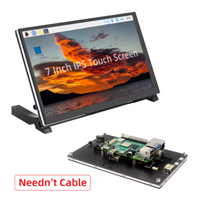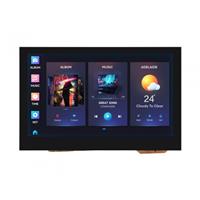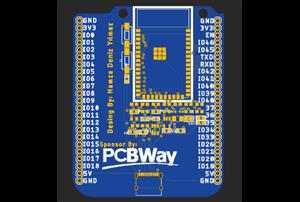|
|
TYPE-C 16PIN 2MD(073) |
x 1 | |
|
|
STM32F405RGT6STMicroelectronics
|
x 1 | |
|
|
sd card module |
x 1 | |

|
NPPC202KFMS-RCSULLINS CONNECTOR SOLUTIONS
|
x 1 |
STM32F4xx Maker PCB MakerST-1
Getting Started with the Maker PCB MakerST-1: Your STM32F4 Adventure Begins!
Hey there, makers and tech enthusiasts! If you’ve been itching to dive into the world of microcontrollers with a powerful yet approachable platform, you’re in for a treat. Today, we’re exploring the Maker PCB MakerST-1, a fantastic board built around the STM32F4 microcontroller series (think STM32F405RGT6, STM32F412RET6, or STM32F446RET6). Whether you’re blinking an LED for the first time or dreaming up a fancy touchscreen project, this guide has got you covered. Let’s break it down step-by-step and have some fun along the way!

What’s So Cool About the MakerST-1 and STM32F4?
The STM32F4: A Tiny Powerhouse
The STM32F4 family from STMicroelectronics is like the superhero of microcontrollers. It’s built on the ARM Cortex-M4 core, which means it’s fast (up to 168 MHz!), efficient, and packed with goodies like a Floating Point Unit (FPU) for math-heavy tasks and DSP instructions for signal processing. Depending on the model, you get 512 KB to 1 MB of Flash memory for your code and 128 KB to 192 KB of SRAM for speedy data juggling. Plus, it’s loaded with peripherals—USB, I2C, SPI, CAN, ADC, timers, you name it. Some models even throw in extras like Ethernet or SDIO for next-level projects.
The MakerST-1 Board: Your Playground
The Maker PCB MakerST-1 takes all that STM32F4 goodness and wraps it in a neat, user-friendly package. Picture this: organized pin headers for easy prototyping, a USB port (micro or USB-C) for power and programming, onboard buttons (Reset, Boot, and a bonus user button), and a handy LED (usually on PC13) for quick tests. It’s got a built-in ST-Link/SWD interface for programming and debugging, and it runs smoothly on a 3.3V supply (some versions handle 5V too). It’s like a Swiss Army knife for your DIY dreams!
Setting Up Your Workspace
Before we get to the fun stuff, let’s set up your development environment. You’ve got a few solid options:
-STM32CubeIDE: Free, all-in-one, and beginner-friendly. It’s got a pin configurator (CubeMX), code generation, and debugging tools built in.
- Keil uVision: A pro favorite, though the free version has limits. Perfect if you’re going big.
- IAR Embedded Workbench: Great for squeezing out max performance—ideal for pros.
- PlatformIO: Open-source and works with Visual Studio Code. Super flexible for multi-platform tinkering.
Pick one, install it (check their docs for details), and let’s get coding!
Blinking an LED: Your First Project
Nothing says “I’m a microcontroller wizard” like making an LED blink. Here’s how to do it with the MakerST-1:
Step 1: Create Your Project
Fire up STM32CubeIDE:
- Go to File > New > STM32 Project.
- Pick your chip (e.g., STM32F405RG) or use the board selector.
- Name your project—something cool like “Blinky" and let it set up the files.
- In the “Pinout & Configuration” tab, set PC13 (or wherever your LED is) as a GPIO Output.
- Head to “Clock Configuration” and crank it up to 168 MHz (or your chip’s max).
- Hit “Generate Code” and watch the magic happen.
Step 2: Write the Code
Open `Core/Src/main.c` and find the `while (1)` loop. Add this:
while (1) { HAL_GPIO_TogglePin(GPIOC, GPIO_PIN_13); // Flip PC13 on and off HAL_Delay(500); // Chill for half a second }
This toggles the LED every 500 milliseconds—simple, right?
Step 3: Flash and Test
Plug your MakerST-1 into your PC via USB, hit Run > Debug (or Run) in CubeIDE, and upload the code. If all goes well, that LED should start winking at you. Debugging tip: Use the built-in tools to peek at registers or add serial logs if things get funky.
Leveling Up: Cool Project Ideas
Once you’ve mastered the blink, the sky’s the limit! Here are some ideas to flex your MakerST-1 muscles:
1. Sensor Fun
Hook up an MPU6050 (motion), BMP280 (pressure), or BME280 (weather) via I2C or SPI. Read data, process it, and maybe display it on a tiny LCD or send it over serial.
2. USB Magic
Turn your board into a virtual serial port (CDC) for PC communication or a HID device (like a custom keyboard). Perfect for controlling stuff from your computer!
3. Audio Adventures
Add a microphone, tap into the Cortex-M4’s DSP powers, and play with real-time audio filters or FFTs. Think voice effects or a mini sound analyzer.
4. Motor Madness
Use PWM and timers to drive DC or stepper motors. Add some encoder feedback, and you’re on your way to a robot or precision controller.
5. Touchscreen Dreams
Connect a TFT display (via SPI or FSMC), throw in a touch panel, and use a library like LVGL to build slick GUIs—think dashboards or game interfaces.
Inside the STM32F4: What Makes It Tick?
Let’s geek out a bit on what powers this board:
- Cortex-M4 Core: A 3-stage pipeline keeps things snappy, with DSP and FPU for heavy lifting.
- Memory: Flash for code, SRAM for data, and an **ART Accelerator** to keep the CPU humming.
- Buses: AHB for fast stuff, APB for peripherals—everything talks smoothly.
- Peripherals: Tons of options—ADC, DAC, USB, CAN, and more. Some chips even have Ethernet!
- Power & Boot: Runs at 3.3V with low-power modes. Boot0 pin decides if it’s bootloader or program time.
Pro Tips for Smooth Sailing
- Hardware: Keep your power clean (good 3.3V regulation), nail the crystal setup, and leave SWD pins accessible.
- Code: Use HAL or LL libraries, keep it modular, and maybe try FreeRTOS for multitasking.
- Performance: Lean on the FPU and DMA, tweak clocks, and handle interrupts smartly.
- Debugging: SWD is your friend—step through code, log stuff, and test like crazy.
Wrapping Up
The Maker PCB MakerST-1 and STM32F4 combo is a goldmine for makers. From blinking LEDs to building touchscreen gadgets, it’s a platform that grows with you. So grab your board, fire up your IDE, and start tinkering—every project is a chance to learn something new. Happy making!
Shoutouts to Our Sponsors
Big thanks to PCBWay and Avnet Silica for backing this project!
PCBWay: Your PCB Bestie
Since 2003, PCBWay has been churning out top-notch PCBs with quick turnarounds and wallet-friendly prices. Prototypes, mass production, SMT assembly—they’ve got it all, plus a slick online platform and stellar support.
Avnet: Tech Titans
With over 50 years in the game, Avnet’s a global powerhouse in components and solutions. From semiconductors to IoT goodies, they’ve got the goods and the know-how to make your project shine.
STM32F4xx Maker PCB MakerST-1
*PCBWay community is a sharing platform. We are not responsible for any design issues and parameter issues (board thickness, surface finish, etc.) you choose.


Raspberry Pi 5 7 Inch Touch Screen IPS 1024x600 HD LCD HDMI-compatible Display for RPI 4B 3B+ OPI 5 AIDA64 PC Secondary Screen(Without Speaker)
BUY NOW
ESP32-S3 4.3inch Capacitive Touch Display Development Board, 800×480, 5-point Touch, 32-bit LX7 Dual-core Processor
BUY NOW
Raspberry Pi 5 7 Inch Touch Screen IPS 1024x600 HD LCD HDMI-compatible Display for RPI 4B 3B+ OPI 5 AIDA64 PC Secondary Screen(Without Speaker)
BUY NOW- Comments(0)
- Likes(2)
 Log in to post comments.
Log in to post comments.
-
 Engineer
Mar 31,2025
Engineer
Mar 31,2025
-
 Hamza Deniz Yılmaz
Mar 10,2025
Hamza Deniz Yılmaz
Mar 10,2025
- 0 USER VOTES
- YOUR VOTE 0.00 0.00
- 1
- 2
- 3
- 4
- 5
- 6
- 7
- 8
- 9
- 10
- 1
- 2
- 3
- 4
- 5
- 6
- 7
- 8
- 9
- 10
- 1
- 2
- 3
- 4
- 5
- 6
- 7
- 8
- 9
- 10
- 1
- 2
- 3
- 4
- 5
- 6
- 7
- 8
- 9
- 10
 More by Hamza Deniz Yılmaz
More by Hamza Deniz Yılmaz
-
 Esp32-S2-Wroom borad
For more information about this project:https://www.hackster.io/hamzadenizyilmaz/esp32-s2-wroom-bora...
Esp32-S2-Wroom borad
For more information about this project:https://www.hackster.io/hamzadenizyilmaz/esp32-s2-wroom-bora...
-
 KeyboradPad
WARNING: The design of this project belongs to me, it can not be used without permission.WARNING: Th...
KeyboradPad
WARNING: The design of this project belongs to me, it can not be used without permission.WARNING: Th...
-
 MotorDuıno
For more information:https://www.hackster.io/hamzadenizyilmaz/motorduino-3c544d
MotorDuıno
For more information:https://www.hackster.io/hamzadenizyilmaz/motorduino-3c544d
-
 NumberPad V2
For more information:https://www.hackster.io/hamzadenizyilmaz/numberpad-v2-5acffeVideo:https://www.y...
NumberPad V2
For more information:https://www.hackster.io/hamzadenizyilmaz/numberpad-v2-5acffeVideo:https://www.y...
-
 Number Pad
For more information and codes:https://www.hackster.io/hamzadenizyilmaz/numberpad-41848e
Number Pad
For more information and codes:https://www.hackster.io/hamzadenizyilmaz/numberpad-41848e
-
 Making Macropad with Attiny85
For more information and codes:https://www.hackster.io/hamzadenizyilmaz14022008/making-macropad-with...
Making Macropad with Attiny85
For more information and codes:https://www.hackster.io/hamzadenizyilmaz14022008/making-macropad-with...
-
 L298N Borad
L298N is a widely used motor driver IC. This integrated is a solution for controlling DC motors or s...
L298N Borad
L298N is a widely used motor driver IC. This integrated is a solution for controlling DC motors or s...
-
 STM32F4xx Maker PCB MakerST-1
Getting Started with the Maker PCB MakerST-1: Your STM32F4 Adventure Begins!Hey there, makers and te...
STM32F4xx Maker PCB MakerST-1
Getting Started with the Maker PCB MakerST-1: Your STM32F4 Adventure Begins!Hey there, makers and te...
-
 Discover the Next Generation Development Platform with ATmega32U4 Based Uptimes Developers Board
IntroductionFor engineers developing electronic projects, hobbyists, enthusiasts and prototypers, fi...
Discover the Next Generation Development Platform with ATmega32U4 Based Uptimes Developers Board
IntroductionFor engineers developing electronic projects, hobbyists, enthusiasts and prototypers, fi...
-
 ESP32-C3-MINI-1 MacroPad
ESP32-C3-MINI-1 What is it ?ESP32-C3-MINI-1 is a microcontroller board developed by Espressif System...
ESP32-C3-MINI-1 MacroPad
ESP32-C3-MINI-1 What is it ?ESP32-C3-MINI-1 is a microcontroller board developed by Espressif System...
-
 ESP32-Controller-Board
Objectives of the Project:Building a simple relay control circuit using an ESP32 microcontroller. To...
ESP32-Controller-Board
Objectives of the Project:Building a simple relay control circuit using an ESP32 microcontroller. To...
-
 Multi-Controlled Robot Card_V1
For more information: https://www.hackster.io/hamzadenizyilmaz/multi-controlled-robot-card-v1-91f67c
Multi-Controlled Robot Card_V1
For more information: https://www.hackster.io/hamzadenizyilmaz/multi-controlled-robot-card-v1-91f67c
-
 Atmega32u4 Pro Micro PCB design
For more information:https://www.hackster.io/504629/atmega32u4-pro-micro-pcb-design-4e3baf
Atmega32u4 Pro Micro PCB design
For more information:https://www.hackster.io/504629/atmega32u4-pro-micro-pcb-design-4e3baf
-
 Esp32-S2-Wroom and Relay
For more, go to the link below:https://www.hackster.io/hamzadenizyilmaz/esp32-s2-wroom-and-relay-e0f...
Esp32-S2-Wroom and Relay
For more, go to the link below:https://www.hackster.io/hamzadenizyilmaz/esp32-s2-wroom-and-relay-e0f...
-
 ESP32-WROOM-32E-cart
FOR MORE INFORMATION:https://www.hackster.io/hamzadenizyilmaz/esp32-wroom-32e-cart-15601c
ESP32-WROOM-32E-cart
FOR MORE INFORMATION:https://www.hackster.io/hamzadenizyilmaz/esp32-wroom-32e-cart-15601c
-
 Wireless Communication with NRF24 and Arduino Pro Micro
FOR MORE INFORMATION:https://www.hackster.io/hamzadenizyilmaz/wireless-communication-with-nrf24-and-...
Wireless Communication with NRF24 and Arduino Pro Micro
FOR MORE INFORMATION:https://www.hackster.io/hamzadenizyilmaz/wireless-communication-with-nrf24-and-...
-
 Esp32-S2-Wroom borad
For more information about this project:https://www.hackster.io/hamzadenizyilmaz/esp32-s2-wroom-bora...
Esp32-S2-Wroom borad
For more information about this project:https://www.hackster.io/hamzadenizyilmaz/esp32-s2-wroom-bora...
-
 KeyboradPad
WARNING: The design of this project belongs to me, it can not be used without permission.WARNING: Th...
KeyboradPad
WARNING: The design of this project belongs to me, it can not be used without permission.WARNING: Th...
-
 MotorDuıno
For more information:https://www.hackster.io/hamzadenizyilmaz/motorduino-3c544d
MotorDuıno
For more information:https://www.hackster.io/hamzadenizyilmaz/motorduino-3c544d
-
 NumberPad V2
For more information:https://www.hackster.io/hamzadenizyilmaz/numberpad-v2-5acffeVideo:https://www.y...
NumberPad V2
For more information:https://www.hackster.io/hamzadenizyilmaz/numberpad-v2-5acffeVideo:https://www.y...
-
 Number Pad
For more information and codes:https://www.hackster.io/hamzadenizyilmaz/numberpad-41848e
Number Pad
For more information and codes:https://www.hackster.io/hamzadenizyilmaz/numberpad-41848e
-
 Making Macropad with Attiny85
For more information and codes:https://www.hackster.io/hamzadenizyilmaz14022008/making-macropad-with...
Making Macropad with Attiny85
For more information and codes:https://www.hackster.io/hamzadenizyilmaz14022008/making-macropad-with...
-
 L298N Borad
L298N is a widely used motor driver IC. This integrated is a solution for controlling DC motors or s...
L298N Borad
L298N is a widely used motor driver IC. This integrated is a solution for controlling DC motors or s...
-
 STM32F4xx Maker PCB MakerST-1
Getting Started with the Maker PCB MakerST-1: Your STM32F4 Adventure Begins!Hey there, makers and te...
STM32F4xx Maker PCB MakerST-1
Getting Started with the Maker PCB MakerST-1: Your STM32F4 Adventure Begins!Hey there, makers and te...
-
 Discover the Next Generation Development Platform with ATmega32U4 Based Uptimes Developers Board
IntroductionFor engineers developing electronic projects, hobbyists, enthusiasts and prototypers, fi...
Discover the Next Generation Development Platform with ATmega32U4 Based Uptimes Developers Board
IntroductionFor engineers developing electronic projects, hobbyists, enthusiasts and prototypers, fi...
-
 ESP32-C3-MINI-1 MacroPad
ESP32-C3-MINI-1 What is it ?ESP32-C3-MINI-1 is a microcontroller board developed by Espressif System...
ESP32-C3-MINI-1 MacroPad
ESP32-C3-MINI-1 What is it ?ESP32-C3-MINI-1 is a microcontroller board developed by Espressif System...
-
 ESP32-Controller-Board
Objectives of the Project:Building a simple relay control circuit using an ESP32 microcontroller. To...
ESP32-Controller-Board
Objectives of the Project:Building a simple relay control circuit using an ESP32 microcontroller. To...
-
 Multi-Controlled Robot Card_V1
For more information: https://www.hackster.io/hamzadenizyilmaz/multi-controlled-robot-card-v1-91f67c
Multi-Controlled Robot Card_V1
For more information: https://www.hackster.io/hamzadenizyilmaz/multi-controlled-robot-card-v1-91f67c
-
-
Commodore 64 1541-II 1581 Floppy Disk Drive C64 Power Supply Unit USB-C 5V 12V DIN connector 5.25
183 1 3 -
Easy to print simple stacking organizer with drawers
90 0 0 -
-
-
-
Modifying a Hotplate to a Reflow Solder Station
1161 1 6 -
MPL3115A2 Barometric Pressure, Altitude, and Temperature Sensor
651 0 1 -
-
Nintendo 64DD Replacement Shell
498 0 2 -
V2 Commodore AMIGA USB-C Power Sink Delivery High Efficiency Supply Triple Output 5V ±12V OLED display ATARI compatible shark 100W
1472 4 3










































